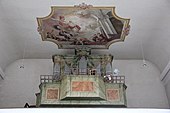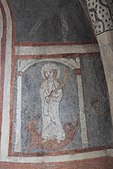St. Vitus (Kottingwörth)
The Catholic parish church of St. Vitus in Kottingwörth , a district of Beilngries in the Upper Bavarian district of Eichstätt , is a Baroque church that was built in the second half of the 18th century on the site of a medieval fortified church . Because of its imposing towers, the church consecrated to St. Vitus is also known as the Little Cathedral in the Altmühltal . The church, in which the early Gothic wall paintings are preserved, is one of the protected architectural monuments in Bavaria.
history
The first church in the settlement Kottenwörth, which was probably built in the 9th century, was probably made of wood. The first stone church was built in the 12th century, in which the Eichstätt Prince-Bishop Otto consecrated the altar between 1183 and 1195 . Remnants of walls from this church building have been preserved in the two towers of the south facade. The western tower was built around 1250, the eastern one with the nave around 1310. The ground floor of the east tower, today's Vitus Chapel, was originally the choir of the east- facing church, the west tower formed the end of the nave in the west. In the first half of the 16th century, the two towers were raised and given pyramid roofs . In the course of the construction of the baroque nave, the towers were given their current onion domes . In the years 1760/61, the medieval church building was replaced by a baroque new building, with the two towers being incorporated into a double tower facade on the south side of the church, which is now facing north. The plans for the new church were designed by the master builder Giovanni Domenico Barbieri (1704–1764) from Roveredo in Graubünden . In 1763 the church was consecrated by the Eichstätt Prince-Bishop Raymund Anton von Strasoldo (1718–1781). In 1891, during renovation work in the Vitus Chapel, whitewashed wall paintings from the 14th century were discovered and exposed again by 1895. The layers of paint from the late Gothic and early renaissance periods above were destroyed.
architecture
Fortified church complex
Church and cemetery are surrounded by a wall up to four meters high, which suggests the function of a fortified church, which served the population as a refuge in times of war. A gate tower from the 16th century with a stepped gable and gable roof provides access . On the inside of the cemetery wall, so-called gaden were originally built, small storage tanks that are no longer preserved.
Exterior construction
The main portal, framed by pilasters and a segmented gable , opens in the middle of the south facade flanked by the two towers . A large rectangular window has been cut above the portal; a Madonna and Child and Saint Willibald , the patron saint of the Eichstätt diocese , are set in the side niches . The gable is broken through by a transverse oval window.
inner space
The interior, a hall structure with a length of 27 meters and a width of 23 meters, consists of a nave with three axes and a retracted, semicircular closed choir, to which a basket arched choir arch leads. The choir and nave have flat ceilings with wide covings .
Ceiling frescoes
The ceiling frescos in the choir and nave were created in 1761 by Christian Erhardt (1731–1805), a nephew and student of Johann Georg Bergmüller , the director of the Imperial City Art Academy in Augsburg . The frescoes are dedicated to St. Vitus, the patron saint of the church. The nave fresco shows the expulsion of the devil from the son of the Roman emperor Diocletian by St. Vitus. In addition to the signature of the painter ("Christian Erhardt Pinx: aug: 1761"), the fresco also shows that of his restorers ("Fratres Wirsching restaur: a. 1889.").
The fresco above the organ shows St. Vitus to whom Jesus appears in prison.
On the choir fresco he is shown with his attributes , the martyr's palm and the oil kettle. On the left side the diocese can be seen insignia like a miter , the bishop's staff and a lecture cross . An angel holds a picture of the new Kottingwörther Church in his hand. The coat of arms of Prince-Bishop Raymund Anton von Strasoldo with his motto "Intima Candent" (burning inside) is attached to the choir arch.
Vitus Chapel
The Vitus Chapel on the ground floor of the eastern tower was used as a choir from 1310 until the new Baroque church was built. The chapel is a square room covered with a ribbed vault , the vaulted ribs of which rest on consoles . The Vitus Chapel is used today as a baptistery, as indicated by the neo-Romanesque baptismal font from 1894. The four paradise rivers Gihon (Gehon), Phison, Euphrates and Tigris are shown at the edge of the pool .
Wall and ceiling paintings
The early Gothic paintings, executed in fresco and secco technique, were probably made after 1313 and originally covered the entire room. The scenes and figures are painted on a blue-gray background, the architectural forms are in white and red, the figurative scenes in white, red, brown and black.
On the reveal of the former choir arch, St. Willibald is depicted as a bishop, opposite him the martyrdom of St. Erasmus , whose intestines are pulled out with a winch, and that of a bishop (perhaps St. Leodegar ) whose teeth are knocked out .
On the inside of the choir arch you can see Cain and Abel , both of whom are making a sacrifice to God. Cain is shown with a sheaf of corn, Abel with a lamb, from a cloud protrudes the hand of God, which blesses Abel's sacrifice.
On the lower level, figures can be seen on all three sides, standing under arched arcades . The apostles and their attributes can be seen on the north and east sides. The Last Judgment is shown above the apostles on the north side . In the middle you can see the Archangel Michael , who weighs the souls, on the left standing Mary , behind her Adam and Eve , on the right devils pull people with a rope into the fire of hell.
A Romanesque window with a deep reveal is still preserved on the east wall. On the lower image level, the apostles Peter with a key and Paul with a sword can be seen on the left;
The upper picture level on the east side is dedicated to St. Vitus. On the left he is led in front of the Emperor Diocletian, in the middle he is martyred on stakes with his foster parents, St. Crescentia and St. Modestus , on the right he is put into a glowing furnace, an angel holds his protective hand over him .
The paintings on the south side were partially destroyed by enlarging the window. There are two female saints with ointment vessels and St. Margaret with a dragon at her feet. In the upper part, two knights can be seen sitting on horses.
On the vaulted caps, Christ as the ruler of the world , surrounded by a mandorla , is depicted and the evangelist symbols for Luke (bull) and Matthew (human figure), John (eagle) and Mark (lion) arranged in pairs . On the western vault cap you can see the martyrs Stephen with a large stone and Laurentius with a grate.
Sacrament House
On the north wall of the chapel there is a sacrament house made of limestone, which was created by the Eichstatt Renaissance sculptor Loy Hering (1484 / 84–1554) around 1520. In the lower part it shows the coat of arms of the Eichstätt prince-bishop Gabriel von Eyb (1455-1535).
Kottingwörther Altar
The so-called Kottingwörther Altar , a late Gothic winged altar from around 1490, originally stood in the Vitus Chapel. At the instigation of the Bishop of Eichstätt, Franz Leopold von Leonrod (1827–1905), the altar was transferred to the episcopal house chapel in Eichstätt in 1868. The altar consists of carved figures, reliefs and panel paintings depicting scenes from the life of the church patron.
Furnishing
- The four-column high altar was created in the late Rococo style in the 1760s . The altar painting is marked with the year 1766 and bears the signature of Christian Dominikus Erhardt. It depicts the martyrdom of St. Vitus being tortured in a cauldron of boiling oil. The extract shows the coronation of Mary and is crowned by the coat of arms of Prince-Bishop Raymund Anton von Strasoldo.
- The two side altars were made in 1787, presumably in the same workshop as the high altar. In the center of the eastern altar is a figure of St. Sebastian from the time the altar was made. The crescent moon Madonna with child in the central niche of the western altar is a late Gothic figure from around 1500. The excerpts depict St. Joseph with the baby Jesus on the Sebastian altar and the instruction of Mary by St. Anna on the altar of Mary .
- The pulpit was created in 1761, also in the late Rococo style. The pulpit is decorated with putti on the lower edge, and a figure of the Apostle Paul stands on the sound cover .
- On the west wall of the nave there is a somewhat weathered sandstone relief from the mid-15th century, which was originally on the outside wall of the church. On the relief the adoration of the Magi is shown under three-pass arches .
- On the nave walls, the two patron saints of the Eichstätt diocese, St. Willibald and St. Walburga , face each other. The two figures from the second half of the 18th century originally stood in the niches on the outer wall of the south facade. Both figures hold an abbot's staff and a book in their hands, on the book of St. Walburga you can see her attribute, a vessel with Walburgis oil .
- The painted stations of the cross are dated after 1760 and attributed to Christian Erhardt.
- The baptismal font under the gallery dates from the 15th century. The bowl is decorated with a Gothic blend of tracery . The figure of John the Baptist on the lid comes from the Baroque period.
organ
The organ prospect is still from the time the church was built. Today's organ work was created in 1938 by the Bittner organ building company in Eichstätt.
Peal
The ringing consists of four bells. Two small bells date from around 1500 and were made in a Nuremberg workshop. They are decorated with a pointed arch frieze and are inscribed in Gothic minuscule . According to the inscription , a bell was cast by Urs Laubscher in Ingolstadt in 1688 . Another bell was made in 1706 in the workshop of Wolfgang Wilhelm Schelchshorn in Eichstätt.
literature
- Georg Dehio : Handbook of the German art monuments. Bayern IV: Munich and Upper Bavaria . 2nd edition, Deutscher Kunstverlag, Munich 2002, ISBN 3-422-03010-7 , pp. 560-561.
- Monika Soffner-Loibl: Kottingwörth. Catholic parish church St. Vitus . Peda-Kunstführer Nr. 977, Kunstverlag Peda, Passau 2016, ISBN 978-3-89643-977-2 .
- Gottfried Weber: The Romanesque in Upper Bavaria . Gondrom Verlag, Bindlach 1990, ISBN 3-8112-0703-2 , p. 430.
Web links
- The Kottingwörther Parish Church Association for Tradition and Culture in Kottingwörth e. V.
Individual evidence
- ^ Monument list for Beilngries (PDF) at the Bavarian State Office for Monument Preservation, monument number D-1-76-114-137 .
Coordinates: 49 ° 1 ′ 12.1 ″ N , 11 ° 31 ′ 6.8 ″ E










































